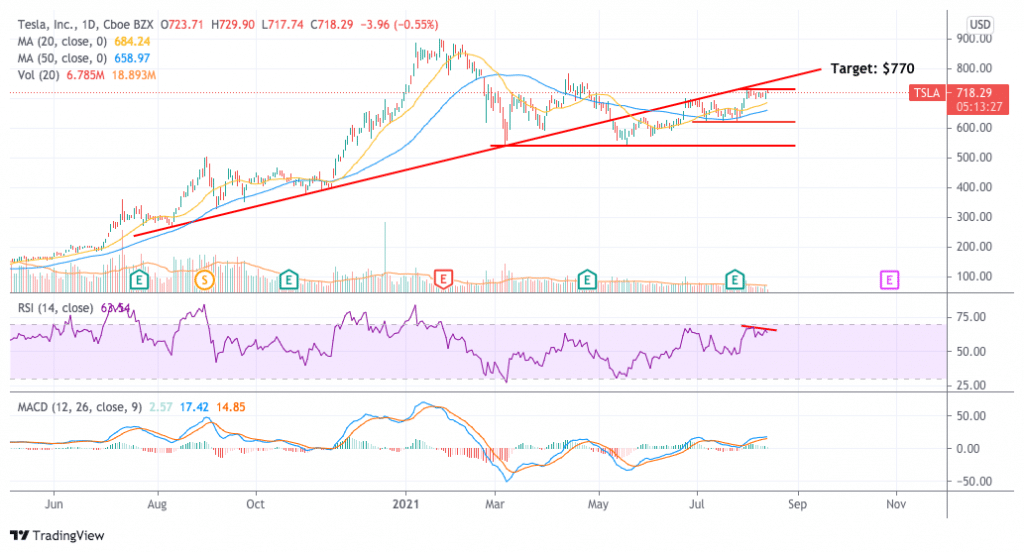Tesla Stock Up 5% In August – Time to Buy TSLA Stock?
Please note that we are not authorised to provide any investment advice. The content on this page is for information purposes only.
Tesla shares have jumped 5% so far in August following the release of an upbeat quarterly earnings report back in late July where the company beat analysts’ estimates for nearly every metric.
During the second quarter of the year, Tesla delivered 201,304 vehicles or 2.5 times the number of units it handed over to customers during the same period the previous year while revenues landed at $11.96 billion or $560 million above the Street’s estimates.
Moreover, adjusted earnings per share ended the period at $1.45 per share, up $0.44 compared to a year ago and 47 cents higher than the consensus forecast for Q2 2021.
Shares initially advanced 2.2% following the release of the report but positive momentum picked up steam days after as many analysts boosted their price targets for the firm. Notably, Goldman Sachs upgraded the stock from Neutral to Buy along with Jefferies Financial Group. Moreover, Jefferies hiked its price target for the stock to $850 per share while UBS Group, Wells Fargo, and the Royal Bank of Canada did the same.
As per data from Seeking Alpha, the consensus price target for Tesla at the moment stands at $680 per share resulting in a 5.5% downside potential even though multiple price targets stand way above this average.
Considering the multiple positive revisions that Tesla received on the back of this latest quarterly report along with the upbeat tone of the management in regards to the firm’s outlook, could Tesla shares keep climbing to higher levels in the following weeks?
The following article takes a look at the price action to possibly answer that question.
67% of all retail investor accounts lose money when trading CFDs with this provider.
Tesla Stock – Technical Analysis

The chart above shows how Tesla’s recent climb started after a triple bottom formation at the $620 level. Each of those tags seem to have taken place during high-volume trading sessions, which reinforces the relevance of this threshold for market participants.
Meanwhile, momentum readings are currently positive but it is important to note that a divergence has already appeared on the Relative Strength Index as the stock has rejected a climb above the $730 level multiple times.
That divergence is perhaps the only warning signal at the moment that could be foretelling a potential drop in the stock price. However, it is not pronounced enough (yet) to indicate a potential reversal of the uptrend.
With that in mind, if the price surges above the $730 level, the next plausible target for Tesla (TSLA) could be set at $770 for a 5.4% short-term upside.
Tesla Stock – Fundamental Analysis
Tesla’s revenue growth continues to be impressive as the company has moved its top-line results from $7 billion back in 2016 to as much as $31.5 billion in 2020 while sales are expected to jump to $50.3 billion this year for a 59.5% year-on-year climb. This would be the third year of consistently higher revenue growth rates for the electric vehicle manufacturer.
Meanwhile, from 2016 to 2020, the number of vehicles delivered has multiplied by more than 6 times, with Tesla managing to hand over almost 500,000 vehicles last year while a simple run rate of this year’s deliveries points to a total of 800,000 units possibly hander over to clients in 2021.
The firm’s EBITDA has also been progressively improving along with its normalized diluted earnings per share, which have moved from negative $0.57 back in 2016 to positive $1.41 in the past 12 months.
As for its debt, Tesla had only $9.31 billion in long-term debt on assets of $55.15 billion including $16.3 billion in cash and equivalents.
At its current market capitalization of $718 billion, Tesla is being valued at 14 times its forecasted sales for this year. If the company continues to grow its sales at a rate of around 30% per year, the current valuation seems relatively justified.
However, it is important to note that Tesla’s vision is to ultimately produce affordable vehicles. This means that even if the current valuation seems high, it could be failing to price in the significant growth that could come once the company manages to produce electric vehicles that could be bought by the average middle-class citizen of a developing or developed nation.
With that in mind, for those who believe that the firm can keep innovating to a point that such a goal is accomplished, chances are that Tesla could be undervalued at current levels amid the significant untapped demand that would open as a result of that achievement.






